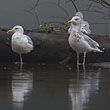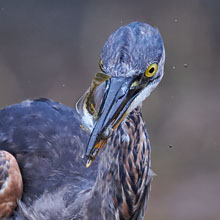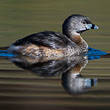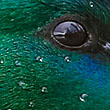Availability: Undetermined - Enquiries?
In the Field
Simply a Grebe. Cowboy Marsh, Columbia Valley, BC, Canada. May 2, 2010.
Painters start with a blank canvas and add bits of paint to it to create their impression of the world. We, as nature/wildlife photographers, are tasked with doing the exact opposite - we must find a way to take the apparent randomness/chaos of nature and simplify and/or organize the visual elements in a way that is aesthetically pleasing. Prior to the age of digital photography the vast majority of photographers were forced to do this while capturing the image and used "traditional" tools to simplify their compositions - things like lens choice, aperture choice, shutter speed choice, and - of course - through a myriad of compositional choices. In the era of modern digital photography we have those same tools, plus have easier access to image processing tools that can also help us "simplify and organize" the elements in an image (such as the clone tool in Photoshop, plus newer tools like the "Content Aware Fill" in Photoshop CS5, etc.). While I'm a big proponent of using digital processing tools and put a lot of effort into my own image processing (spending a LOT of time getting things like the lighting and contrast to my liking), I prefer to do my image "simplification" in the field and strive to remove only artifacts of the photographic process (things like dust specks on the sensor and final image) digitally.
Constructing a successful "simple" image while in the field requires a LOT of fast on-the-fly thinking. In this case of this image of a Pied-billed Grebe I was thinking about things like: Are the out-of-focus zones in the foreground blending well with those in the background? Is the contrast in sharpness between the subject and the foreground/background distinct enough to "focus" attention on the subject? Are the foreground/background colours working together well? Is that beautiful blue reflection in the bird's wake going to show well in the final image? Where the heck should I position the subject in the frame, given the colours I have to work with, the direction of travel of the bird and basic compositional principles? What aperture should I select to give me just enough depth of field for the bird and wake? What shutter speed do I need to freeze the action the way I want? And...you get the picture!
Kinda makes you think a little, eh? Maybe simplicity in photography simply isn't too darned simple!
Behind the Camera
Simply a Grebe. Cowboy Marsh, Columbia Valley, BC, Canada. May 2, 2010.
Digital Capture; RAW 14-bit format; ISO 200.
Nikon D3s with Nikkor 600mm f4 VR lens supported on Gitzo 1348 tripod with Wimberley head. VR on and set to "Normal" mode. Camera gear and photographer concealed under "Qwik Camo" drop-sheet style blind/hide.
1/500s @ f4.5; -0.67 stop compensation from matrix-metered exposure setting.
At the Computer
Simply a Grebe. Cowboy Marsh, Columbia Valley, BC, Canada. May 2, 2010.
RAW Conversion to 16-bit TIFF, including first-pass/capture sharpening using Phase One's Capture One Pro 5. Two RAW conversions at different exposure settings (one at -1 compensation for the water in foreground and background, one at -0.5 stops for the grebe.
Further digital corrections on 16-bit TIFF file using Adobe's Photoshop CS5 and Light Craft's LightZone. Photoshop adjustments included compositing and masking of 2 exposure versions, selective saturation and desaturation of colours, and selective sharpening for web output. Final tonemapping and contrast/tone tweaking performed with LightZone use the (tonemapper/re-light tool).
Conservation
Simply a Grebe. Cowboy Marsh, Columbia Valley, BC, Canada. May 2, 2010.
Ten percent of the revenue generated by this image will be donated to Wildsight.
Species Status in Canada*: This species is not designated as at risk.
The diminutive Pied-billed Grebe (Podilymbus podiceps) has the widest distribution of any of the North American Grebes but tends to be relatively uncommon throughout most of its range. Being a night migrant and a "crash diving" species (i.e., one that escapes danger by diving under the water) it is rarely seen in flight. Pied-bills are normally solitary and rarely seen in groups larger than 2 or 3 (except when accompanied by their young). A groups of grebes (of all species) are collectively known as a "water dance."
While Pied-bills are not considered at threat, many ecosystems within the Columbia Valley face development pressure, including wetlands critical to the local survival of Mallards. Wildsight is an effective conservation organization that protects biodiversity and promotes sustainable communities in Canada's Columbia and Rocky Mountains. Support for Wildsight, through donation or becoming a member, will help ensure that they remain effective in their efforts to conserve threatened or endangered species and ecosystems.
*as determined by COSEWIC: The Committee on the Status of Endangered Wildlife in Canada


























